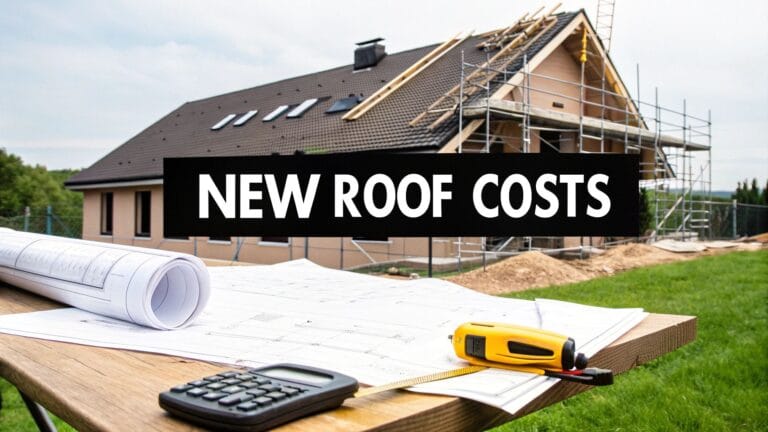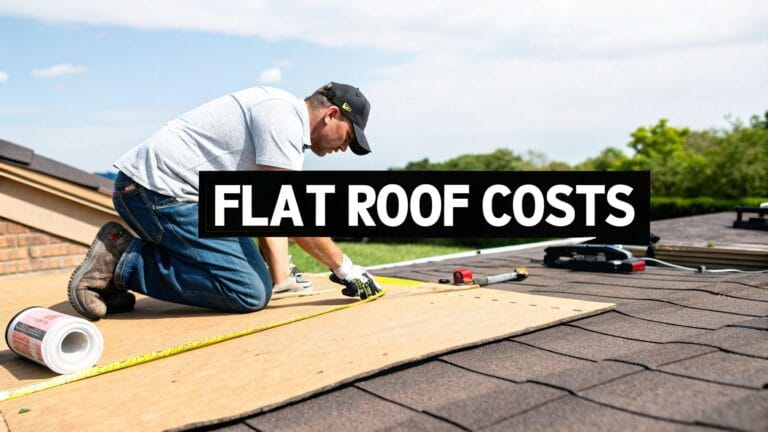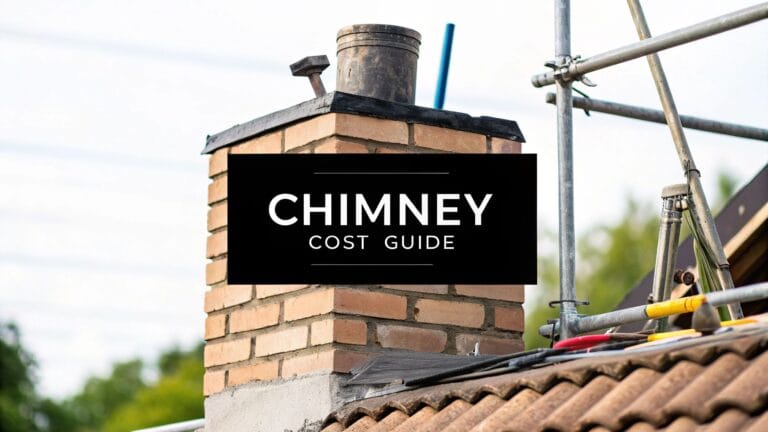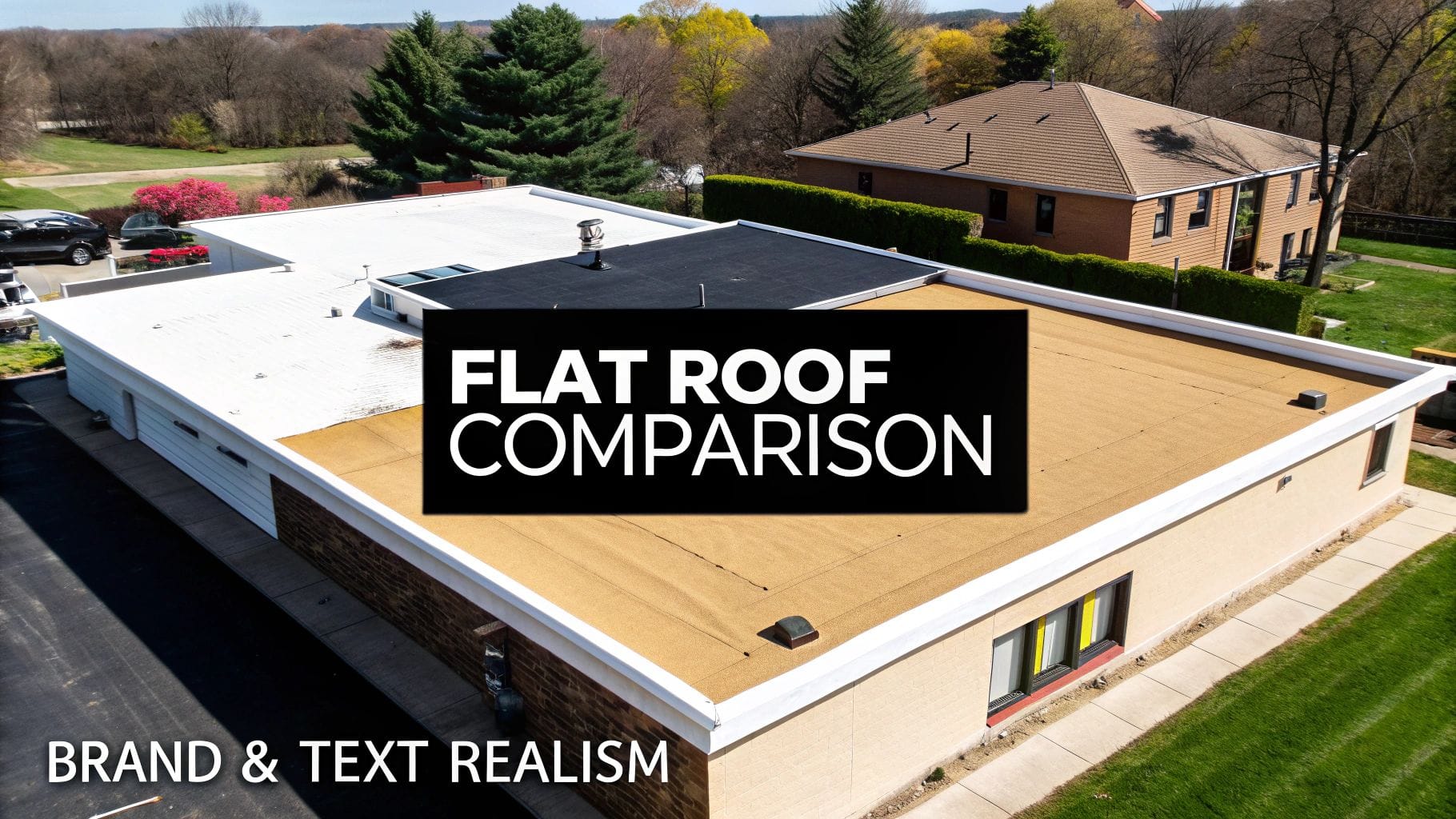
Best Roofing Materials for Flat Roofs in the UK
Discover the best roofing materials for flat roofs. Our expert UK guide compares EPDM, GRP, and felt on cost, durability, and real-world performance.
For homeowners here in the UK, when it comes to the best materials for a flat roof, two options consistently come out on top: EPDM rubber and GRP fibreglass. Both are a world away from traditional felt, offering far superior longevity and weather resistance. They represent a smart, long-term investment against the notoriously damp British climate.
Choosing Your Ideal Flat Roofing Material
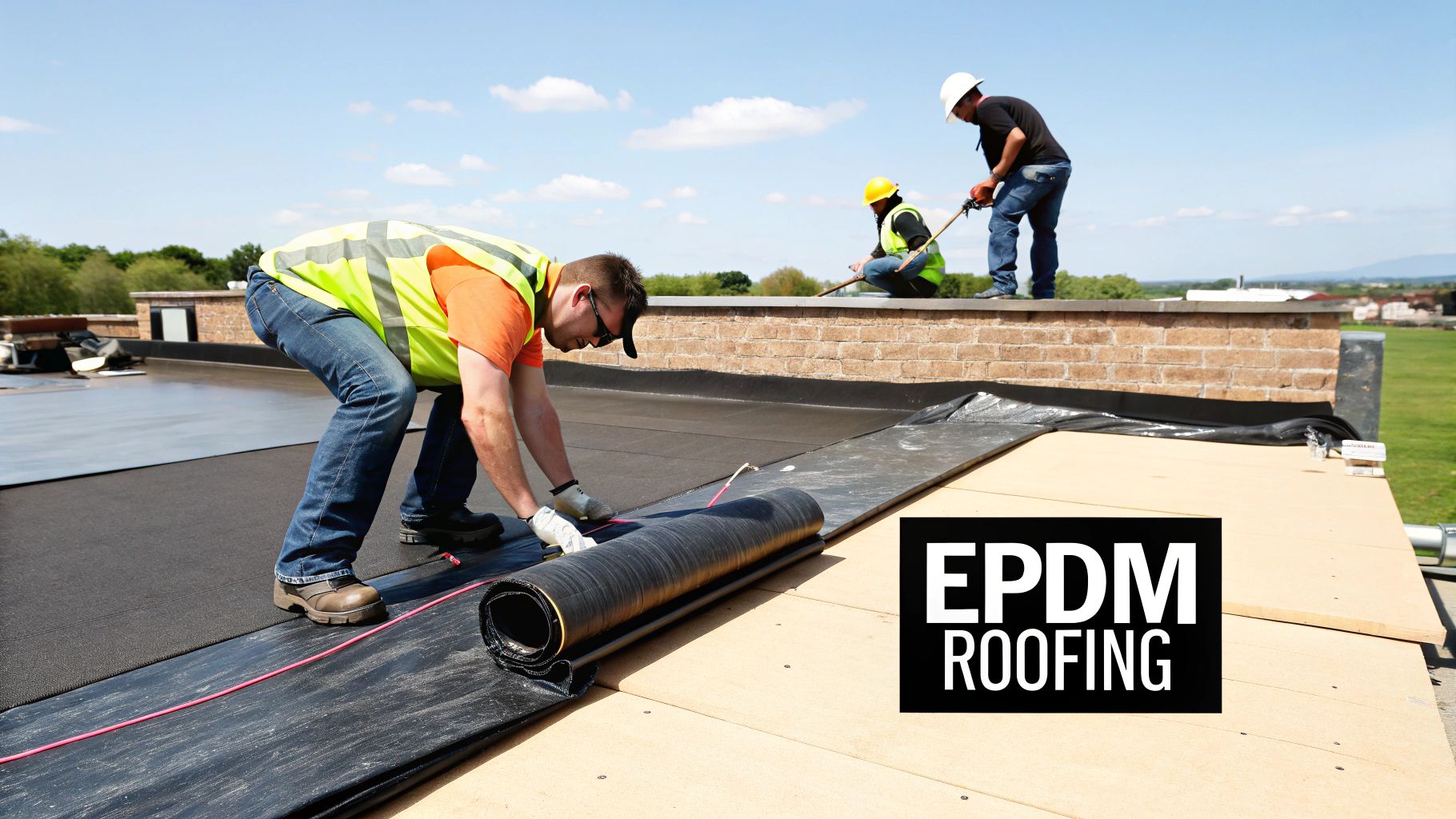
Pinpointing the perfect material for your flat roof is a crucial decision for any UK property owner. It’s a balancing act between cost, durability, and how well it will cope with our often-unpredictable weather. While traditional felt has served its purpose over the years, modern systems now offer huge advantages in both performance and lifespan. The real key is understanding how each one stacks up in real-world UK conditions.
The UK's flat roofing market reflects this mix of old and new. It was valued at around £1.1 billion back in 2020, and the sector is growing, thanks largely to these material innovations. Although built-up felt still makes up about 40% of all installations, more advanced options are quickly gaining ground due to their sheer reliability.
Key Materials at a Glance
To make a confident choice, it’s helpful to know the main contenders. Each has its own unique character, making it suitable for different jobs, whether it's a small garage extension in Sheffield or a large commercial building in London.
Here’s a quick rundown of the top three materials we’ll be comparing:
| Material | Primary Benefit | Best For |
|---|---|---|
| EPDM Rubber | Extreme flexibility and long lifespan | Roofs that experience temperature fluctuations |
| GRP Fibreglass | Seamless, hard-wearing waterproof finish | Roofs with light foot traffic or complex shapes |
| Modified Bitumen | Cost-effective and proven technology | Budget-conscious projects and traditional repairs |
For any property owner, the goal isn’t just to cover a space. It's about investing in long-term protection. The best material is one that stops leaks, needs minimal looking after, and can withstand decades of British rain and sun without failing.
Ultimately, your final choice will come down to your specific needs, your budget, and the unique structure of your property. Before we dive deeper, it helps to be clear on what a flat roof actually involves and why its construction is so different. For a bit more background, take a look at our guide on what is a flat roof?. Here at Evershield Roofing, our experts can help you navigate these options to find a solution that offers genuine peace of mind for years to come.
Comparing the Top Flat Roofing Systems
Choosing the right material for a flat roof isn't just a technical decision; it's about getting the best long-term protection for your property. Here in the UK, that means finding a system that can handle everything from relentless drizzle in Manchester to a surprise heatwave in Kent. Let's break down the three main players: EPDM, GRP Fibreglass, and Modified Bitumen (felt), to see how they really perform in the real world.
This is a bigger deal than ever, as the UK's roofing market is on a steady incline. Projections point to a growth rate of around 3.1% per year between 2025 and 2034, with modern flat roofing systems leading the charge. While traditional felt is still a common sight, newer materials are fast becoming the go-to for durability and performance. You can dig deeper into these UK roofing market trends and forecasts to see the shift for yourself.
EPDM Rubber: A Master of Flexibility
EPDM (Ethylene Propylene Diene Monomer) is a high-performance synthetic rubber, and its biggest advantage is its incredible flexibility. Picture a single, giant sheet of tough rubber laid across your entire roof. That’s essentially what you get. This elasticity is a massive plus in the UK, where our weather causes constant expansion and contraction.
Where more rigid materials can turn brittle and crack under the strain of temperature swings, EPDM simply moves with the building. It’s exceptionally resistant to thermal shock, which is key to maintaining a watertight seal for decades. For our trained roofers at Evershield, installation is often quite quick, especially on large, simple roofs where a single sheet can be used, getting rid of the seams that are notorious weak points.
GRP Fibreglass: The Seamless Protector
GRP (Glass Reinforced Plastic), or fibreglass as it's more commonly known, takes a totally different approach. It’s a liquid system, applied wet over a layer of fibreglass matting. Once cured, it forms one continuous, solid membrane with absolutely no seams, joints, or welds.
This seamless quality makes it an absolute fortress against water, a brilliant choice for roofs where you might get standing water after a downpour. GRP is also incredibly tough. Once it has hardened, it can easily handle being walked on, making it perfect for balconies or any roof that needs to be accessed for maintenance. We frequently recommend GRP for projects like terraces on new-builds or complex roof shapes on period properties.
The core difference comes down to their nature. EPDM is a flexible, pre-formed membrane built to accommodate movement. GRP is a liquid-applied system that creates a hard, seamless shell designed for maximum impact resistance. Your choice often hinges on whether your roof needs to flex or needs to be tough as nails.
Modified Bitumen: The Modern Take on Tradition
Modified Bitumen is the direct descendant of old-school roofing felt, but it’s come a long way. It's built up in multiple layers of asphalt sheets, which are fused together with a torch (torch-on) or with powerful adhesives (cold-applied). The "modified" bit refers to the polymers added to the mix, which give it far better flexibility and a longer life than its predecessors.
While it won't give you the flawless finish of GRP or the fifty-year lifespan of EPDM, modern felt is a solid, budget-friendly option. Its multi-layer design offers a good degree of built-in backup; even if the top layer gets damaged, there are others underneath to keep the water out. It's still a very popular choice, especially for repairs or on projects where keeping costs down is the main priority.
To get a quick idea of how these materials compare on initial cost, this chart shows the average price per square metre for some common options.
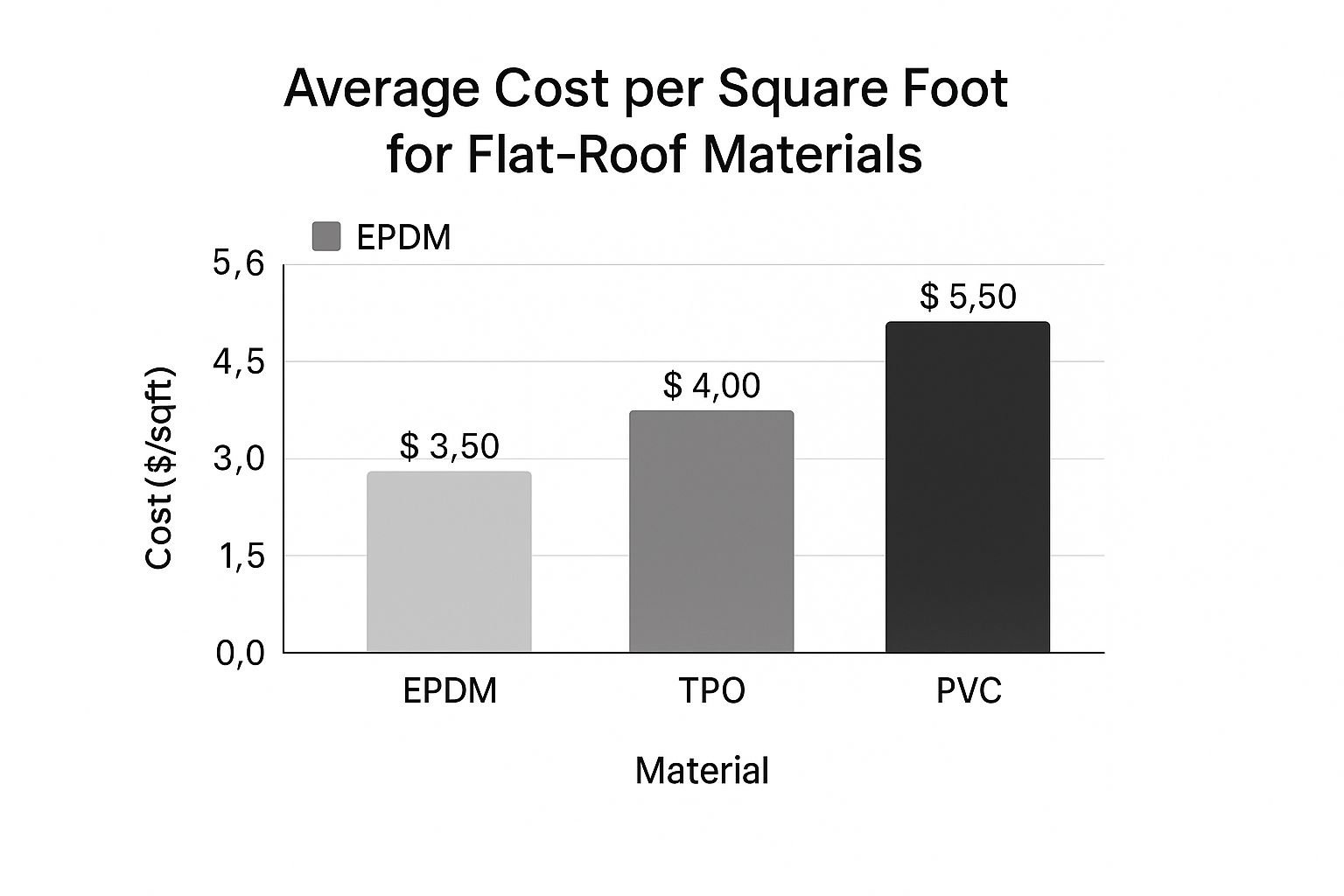
It’s a useful starting point, but remember that the upfront material cost is only one piece of the puzzle when you’re looking at the total investment over the roof's lifetime.
Flat Roofing Materials At a Glance
To quickly compare the key performance attributes of EPDM, GRP, and Bitumen Felt, this table breaks down what really matters for a UK property.
| Material | Average Lifespan | UK Weather Performance | Installation Complexity | Typical Maintenance |
|---|---|---|---|---|
| EPDM | 50+ years | Excellent flexibility handles temperature swings without cracking. | Moderate; requires a clean, dry day. Seams are the main challenge. | Very low. Annual checks for debris and seam integrity are enough. |
| GRP | 30-50 years | Outstanding waterproofing due to its seamless, hard shell. | High; needs specific temperature and dry conditions to cure properly. | Very low. Just needs to be kept clean and checked for physical damage. |
| Bitumen Felt | 10-20 years | Good. The multi-layer system provides robust protection. | Moderate to high, especially for torch-on applications. | Regular checks for blisters, cracks, and seam failures are needed. |
Ultimately, choosing the right material isn't about finding a single "best" option. It's about matching the material’s strengths to what your roof actually needs. An EPDM system that’s perfect for a large, simple extension might not be the best fit for a complex roof with lots of pipes and skylights, where a liquid-applied GRP system would excel. Our team at Evershield Roofing can help you make that call.
Understanding Your Total Roofing Investment
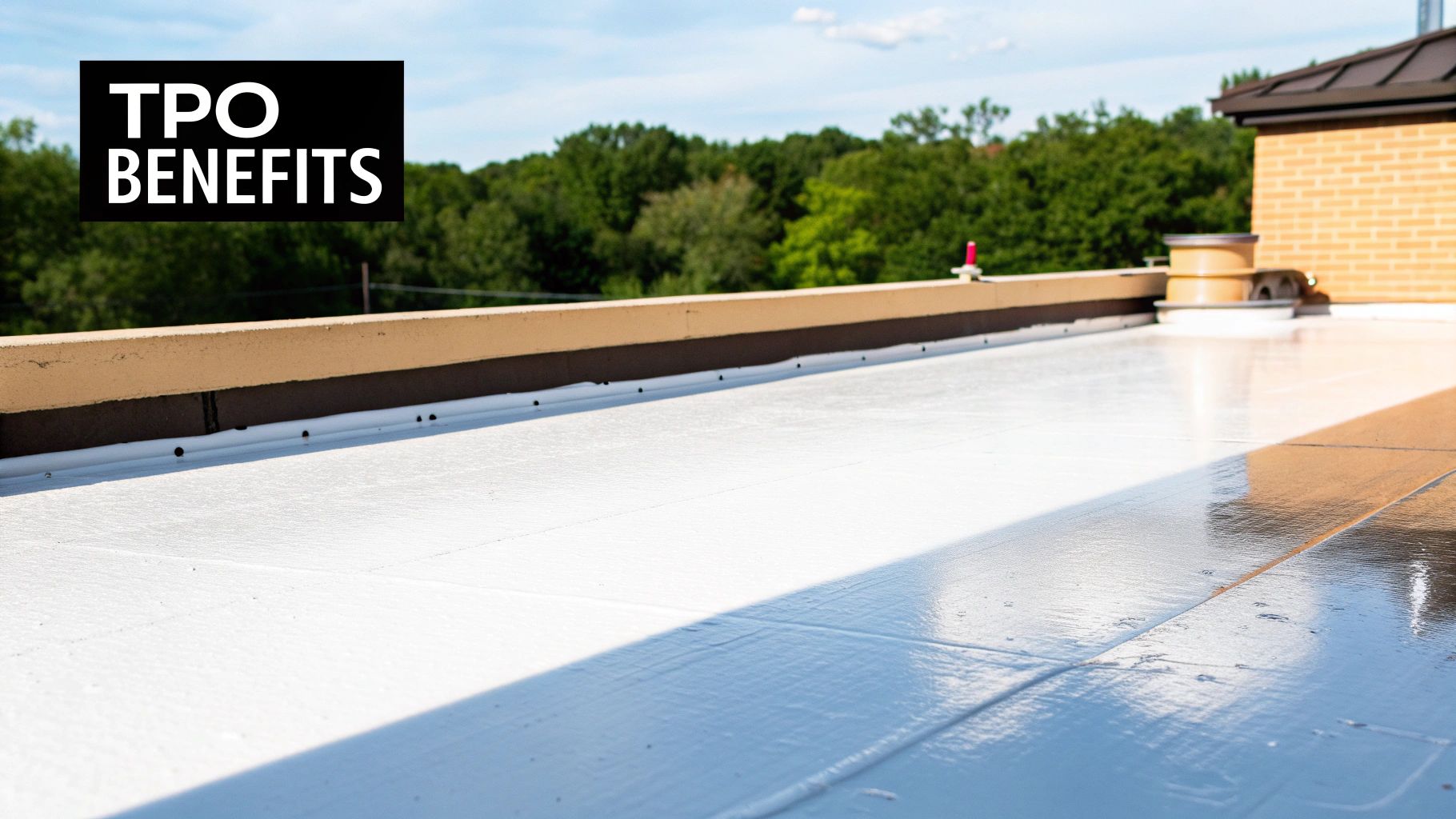
Putting a new flat roof on your property is a serious investment, and the real cost is about much more than the number on the initial quote. To make a smart choice, you need to think about the total cost over the roof's entire life, not just the price you pay today. A cheaper material now can easily turn into a costly headache down the line.
The price of installation is just the beginning. You have to consider things like how long it's expected to last, what kind of maintenance it needs, and how often it might need repairs. This is what we call the lifecycle cost, and it's the key to comparing the best roofing materials for flat roofs properly. It often paints a completely different financial picture.
Breaking Down the Costs Per Square Metre
Here in the UK, the cost to supply and install flat roofing materials varies quite a bit. These figures will give you a solid starting point for your budget, but keep in mind that they're just averages. Your final price can change based on your location, how complex your roof is, and the contractor you choose.
Here’s a general idea of what you can expect to pay:
- Traditional Felt (Modified Bitumen): Usually the most wallet-friendly option upfront, felt roofing typically costs between £50 and £80 per square metre, installed. Its low price makes it an appealing choice if you're focused on initial savings.
- EPDM Rubber: As a solid mid-range choice, EPDM generally lands between £70 and £100 per square metre. That higher initial spend is often justified by its incredible durability and almost non-existent maintenance needs.
- GRP Fibreglass: Often the most premium of the common options, GRP installation ranges from £80 to £120 per square metre. This price reflects the expert skill needed to create that perfect, seamless finish.
A crucial insight for any property owner is that a roof’s value is measured in decades, not just the installation cost. A system that costs 25% more upfront but lasts twice as long and requires virtually no repairs offers far greater long-term financial security.
Why Lifecycle Cost Is the Real Measure of Value
Let's be clear: the cheapest material is almost never the most cost-effective over a 25-year period. A traditional felt roof, for instance, might need a full replacement in just 10-15 years. That means you could end up paying for a new roof twice, or even three times, in the time a single EPDM or GRP roof is still going strong.
On top of that, frequent maintenance and repairs really add up. Small blisters or leaks on a felt roof can quickly become bigger, more expensive problems if you don't catch them early. To get a better handle on this, have a look at our detailed guide to UK flat roof repair costs.
In contrast, modern systems like EPDM and GRP are designed to be "fit-and-forget." They often last well over 40-50 years and usually only need an annual check-up to clear away leaves and debris. Their higher initial cost is balanced out by decades of reliable, stress-free performance. This is the approach we champion at Evershield Roofing, as it protects your property and your bank account from the endless cycle of repairs and replacements.
Which Roofing Material Fits Your Project?
Theory is one thing, but how a roofing material performs in the real world is everything. A system that’s perfect for one roof might be completely wrong for another. The key is to match the strengths of each material to specific, common scenarios you'd find across the UK.
Making this connection moves you from just comparing options to making a confident decision. It ensures your investment is sound and your roof is perfectly suited to your property’s needs, whether it's a small domestic job or a large commercial installation.
For Garage Extensions and Small Outbuildings
Think about a typical single-storey garage extension or a garden room in a suburban home. The main priorities here are usually reliability and value for money. The roof is often a simple, uninterrupted square or rectangle, which makes it a prime candidate for EPDM rubber roofing.
Practical Example: A recent client in Reading needed a new roof for their 20m² garage. They wanted something that would last decades with minimal fuss. We recommended a single-sheet EPDM system. Our team was able to install it in a single day, leaving them with a completely seamless, weatherproof surface guaranteed for 25 years.
For Roofs with Foot Traffic or Complex Shapes
What if your project is a balcony, a terrace, or a roof cluttered with skylights, vents, and awkward angles? This is where GRP fibreglass really shines. Because it's applied as a liquid, it creates a tough, seamless, and totally waterproof membrane that perfectly moulds itself around any obstruction.
Practical Example: We worked on a terraced house in Brighton that had a small first-floor balcony with complex detailing around the railings. GRP was the only logical choice. The liquid application allowed us to form a perfect, watertight seal around every post and corner, creating a durable, non-slip surface the homeowners could use safely.
Your project's intended use is the most critical factor. For a simple covering, EPDM offers unbeatable value and longevity. For a functional surface that needs to be walked on, the robust, seamless finish of GRP provides unmatched resilience.
For Coastal Properties or Harsh Environments
Properties near the coast face a unique assault from the elements: high winds, corrosive salt spray, and intense UV exposure. In these demanding conditions, both EPDM and GRP are excellent contenders. EPDM's chemical stability means it won’t degrade from salt, while GRP's tough, monolithic surface gives fantastic protection against wind-driven rain.
When planning a roof replacement on an older property, it's also smart to be aware of potential hidden hazards. Understanding what homeowners need to know about asbestos in older homes is a crucial first step before any work gets underway.
Choosing the right material is fundamental to your roof's lifespan, a topic we explore in our guide on how long does a flat roof last?. At Evershield Roofing, we can carry out a professional survey to assess your specific situation and recommend the best material for your project, ensuring lasting protection.
Time to Talk to a Flat Roofing Specialist?
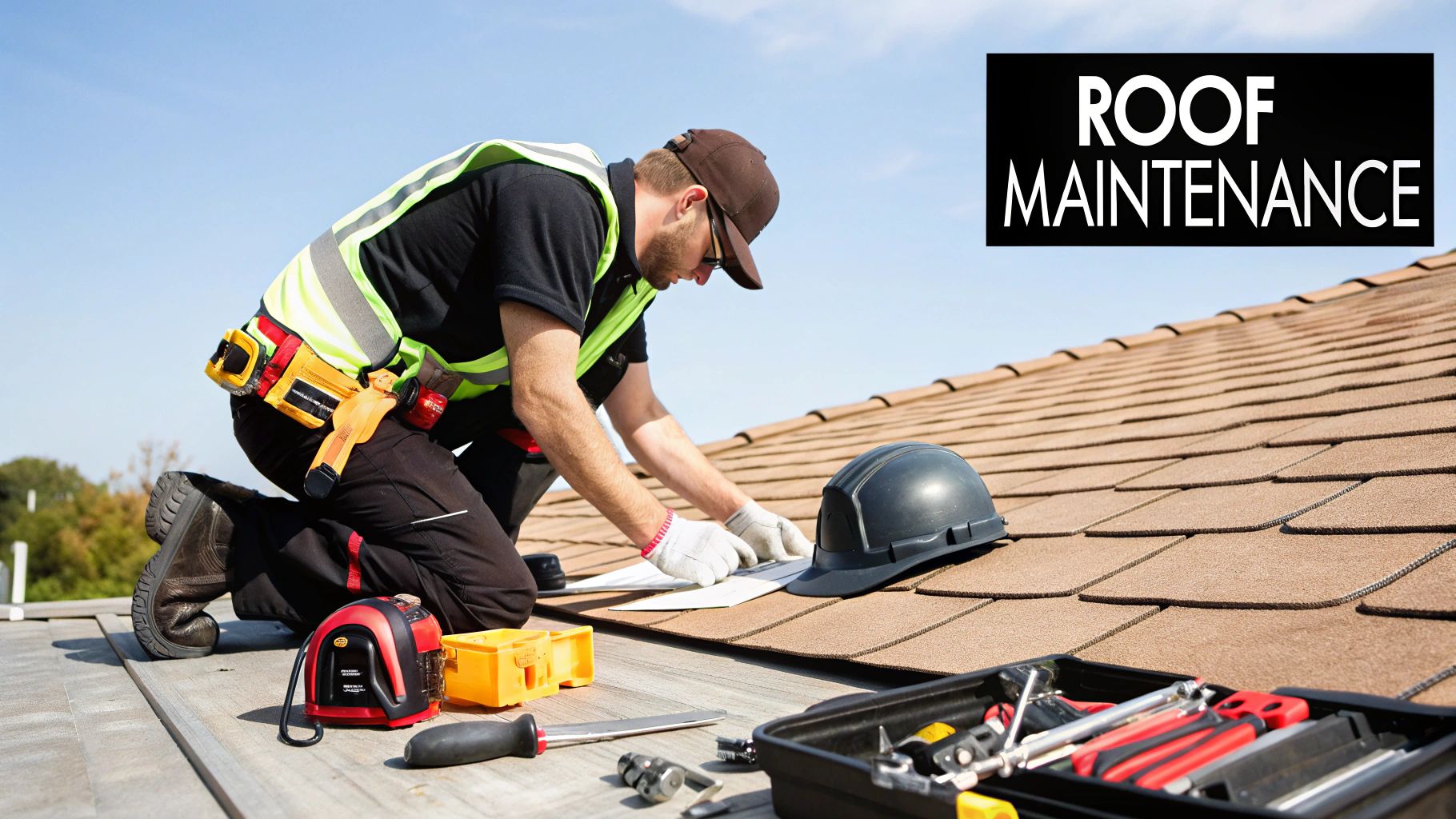
Choosing the right material for your flat roof is a great start, but it’s the quality of the installation that truly determines its lifespan. At Evershield Roofing, we guide you through every stage, making sure your investment is sound from the moment we arrive. It all begins with a proper chat and a detailed survey where we assess your property and, just as importantly, listen to what you need.
This initial on-site review allows us to recommend a roofing system that genuinely fits your requirements and budget. We only work with certified, top-tier materials like EPDM and GRP, so you can be confident that every project we complete is fully compliant with UK building regulations. Our job is to deliver a durable, watertight roof you won’t have to worry about.
Our Promise: Quality and Compliance
We know a new roof is a big decision. That’s why we’ve built our process to be as straightforward and stress-free as possible, from our first conversation to the final handover. Our technicians are not only highly trained but also Firestone-approved, bringing a level of expertise that guarantees a flawless finish on everything from a small home extension to a large commercial building.
The UK roofing industry is growing fast—it's projected to hit US$9.47 billion by 2031, largely driven by homeowners renovating and upgrading to better materials. But as demand grows, so does the shortage of truly skilled roofers. Working with a proven specialist like Evershield Roofing means you're getting certified expertise, not just a roll of material. You can read more about the industry's growth and challenges to see why that matters.
The real value of a professional roofer isn't just in laying the material correctly. It’s in the meticulous preparation, the understanding of building codes, and the commitment to a finish that will withstand years of British weather.
Our goal is simple: to give you a reliable roof and complete peace of mind. We pair the best materials on the market with craftsmanship that protects your property for the long haul.
If you’re ready to get your flat roof sorted properly, get in touch with our team today. We’d be happy to arrange a professional survey and give you a clear, no-obligation quote.
Frequently Asked Questions About Flat Roofing
Even after weighing up all the options, a few final questions often pop up when deciding on the best material for a flat roof. Here are the answers to some of the most common queries we get from property owners across the UK, helping you make that final choice with confidence.
What Is the Most Durable Flat Roofing Material for the UK Climate?
When it comes to standing up to the UK's notoriously wet and changeable weather, both EPDM rubber and GRP fibreglass are serious heavyweights.
EPDM's real strength lies in its incredible flexibility, allowing it to expand and contract with temperature swings without cracking. On the other hand, GRP forms a completely seamless and tough waterproof shell, which is fantastic for any roof that might get a bit of foot traffic. Professionally installed by our teams, you can expect either of these to last 30 to 50 years.
Can I Install a New Flat Roof Over My Existing One?
Sometimes, yes. This is called an 'overlay', and it can be a tempting, cost-saving route if your current roof deck is dry and in good structural nick. Certain single-ply membranes and liquid-applied systems are well-suited for this kind of job.
A word of caution, though: a professional inspection is non-negotiable. If you trap moisture between the old and new layers, you're setting the stage for rot and serious structural problems. That's why, for genuine peace of mind, a complete tear-off is almost always the better long-term bet. We always conduct a thorough survey to advise on the best course of action.
Are There Environmentally Friendly Flat Roofing Options?
Absolutely. If you're looking for a greener solution, EPDM is a great pick. It has a relatively low environmental impact during its manufacturing process and is fully recyclable when it eventually reaches the end of its life.
Another brilliant choice is a green roof, where the entire surface is covered with vegetation. This doesn't just look great—it boosts biodiversity, massively improves insulation, and helps with stormwater management. You could also consider 'cool roof' materials which reflect sunlight and can noticeably cut down on a building's cooling costs in summer.
How Much Maintenance Does a Modern Flat Roof Require?
One of the best things about modern systems like GRP and EPDM is that they're incredibly low-maintenance. All they really need is a quick look-over twice a year, usually in the spring and autumn.
The main jobs are simple: clear off any leaves or debris and make sure your gutters and drains aren't blocked. It's also worth casting an eye over any seams or flashing for damage, though with seamless or professionally welded systems, problems are very rare.
This is a world away from the constant vigilance needed for old felt roofs, which were prone to blistering, cracking, and seam failures.
Choosing the right material is half the battle, but expert installation is what truly locks in that long-term performance. At Evershield Roofing, our specialists provide seasoned advice and flawless installation to ensure your flat roof protects your property for decades to come. Visit us at Evershield Roofing to book your free, no-obligation survey.

